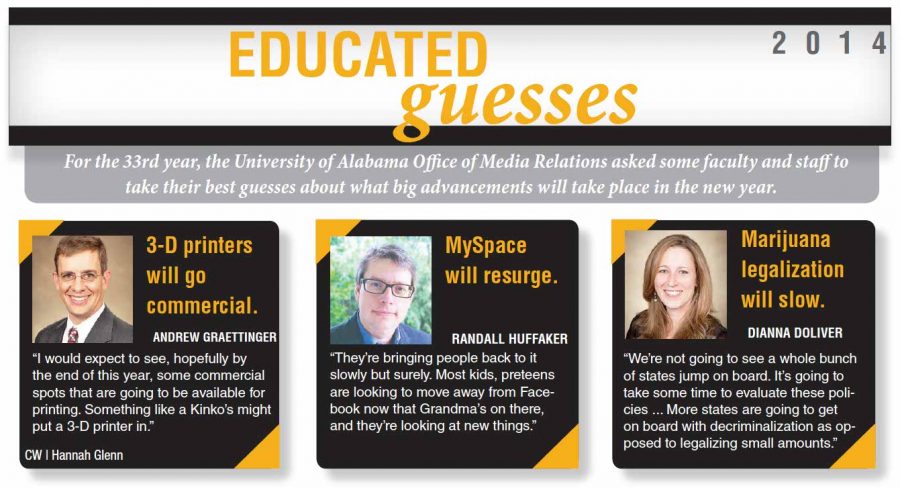A resurgence of MySpace, the return of the slip dress and widespread 3-D printing are just a few of the things we can look forward to in 2014 if The University of Alabama’s annual educated guesses come to pass. For the 33rd year, the University of Alabama Office of Media Relations asked some faculty and staff to take their best guesses about what big advancements will take place in the new year.
“It was just kind of a fun project,” Cathy Andreen, a spokesperson for the University, said. “We asked faculty members to kind of go out on a limb and make predictions in their areas of expertise.”
Andreen said she feels the University has been accurate, for the most part, with their predictions in the past.
“We feel like we have a good track record,” Andreen said. “One year, many years ago, when there was a Major League Baseball strike, we had a professor who actually predicted the day that the strike would end, and he was right.”
But the twists and turns of current events always prove some predictions off the mark.
“Of course, on other occasions, we’ve had someone predict that a particular candidate would win an election, and they didn’t,” Andreen said.
This year, UA faculty and staff predicted a number of changes to occur in the coming year. Randall Huffaker, an instructor in the department of advertising and public relations, predicted that MySpace would have a comeback in 2014.
“When I say resurgence, I mean a very little resurgence,” Huffaker said. “It already has come back a little bit.”
Huffaker predicted that, as the population on Facebook starts to include older generations, teenagers and younger generations would return to the newly-redesigned MySpace, which now has a sharper focus on music.
“They’re bringing people back to it slowly but surely,” Huffaker said. “Most kids, preteens are looking to move away from Facebook now that grandma’s on there, and they’re looking at new things.”
Huffaker also predicted that augmented reality would find its way into social media on the backs of devices like Google Glass.
“You’re taking me out of what’s basically my hand and interacting with the world around me,” Huffaker said. “I think there will be a lot more functionality, a lot more interplay like that that allows me to see what’s going on around me, and I look and experience it at the same time as interacting.”
Andrew Graettinger, director of the UA 3-D Printing Lab and an associate professor in the department of civil, construction and environmental engineering, predicted that household 3-D printers are still a few years off, but the technology would expand into more commercial markets.
Graettinger said 3-D printers are still relatively expensive and complex, with high-quality printers costing $10,000 to $15,000 and lower-quality models going for around $2,000. Current printers are also fairly complex to operate, keeping all but the most dedicated garage tinkerers out of the market.
“I would say you’re probably going to see something in the next five to 10 years, where the prices of those good-quality machines are going to get down into the thousand dollar mark,” Graettinger said. “The ease of printing will be pretty straightforward, so it will almost be like printing something – just push a button and you get your part out.”
Graettinger did, however, predict that 3-D printers would find their way into dedicated businesses this year.
“I would expect to see, hopefully by the end of this year, some commercial spots that are going to be available for printing,” Graettinger said. “Something like a Kinko’s might put a 3-D printer in.”
Although household use might still be a few years off, Graettinger predicted that we would one day see 3-D printers become common appliances.
“It’s becoming more and more popular,” Graettinger said. “It’s going to be part of our lives just like things like the microwave are part of our lives.”
Diana Dolliver, an assistant professor in the department of criminal justice, predicted that the push to legalize marijuana in the United States would slow this year as the rest of the country watches Colorado and Washington work out the logistics of legalization.
“We’re not going to see a whole bunch of states jump on board,” Dolliver said. “It’s going to take some time to evaluate these policies.”
Dolliver said policies on drugged driving would be among the questions law enforcement will have to answer in Colorado and Washington.
“What these two states have done is say that there is no driving under the influence,” Dolliver said. “We’ll have to see if that trend continues or if they get to the point where they allow a little bit, and then how they deal with that.”
Although states might not jump on board full legalization right away, Dolliver said states will continue to decriminalize the drug.
“More states are going to get on board with decriminalization as opposed to legalizing small amounts,” Dolliver said.
Alabama, however, is unlikely to follow the crowd and relax restrictions on marijuana, given the political atmosphere and actions of surrounding states, Dolliver said.
Besides a MySpace comeback, 3-D printing at Kinko’s and slowed marijuana legalization, other professors and instructors predicted that 2014 will be an eventful year.
University faculty and staff predicted, among other things, that car manufacturers will start making luxury hybrid plug-in cars; sports concussions, particularly in young people, will result in federal legislation; the NSA controversy will result in increased mobile phone encryption; slip dresses would come back into fashion and targeted advertising would be made easier in 2014.
To see the full list of this year’s educated guesses, visit uanews.ua.edu.







